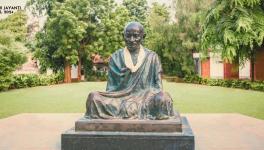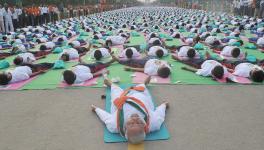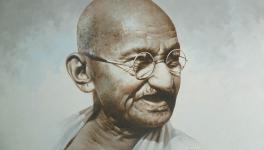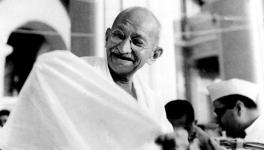Sunak’s ‘Arrival’ Revives Memories of Indentured Indian Labour During 19th Century
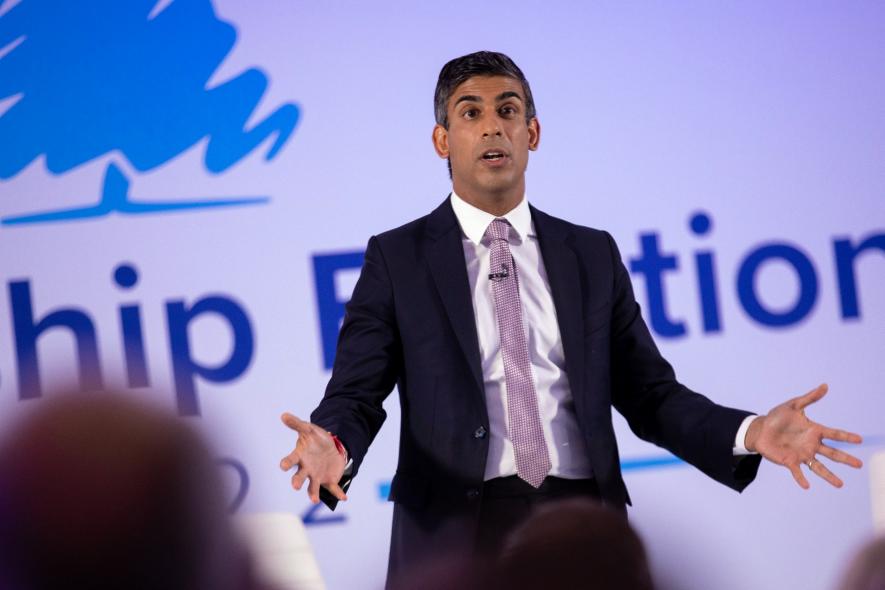
Rishi Sunak.Image Courtesy: PTI
[There is much celebration of Rishi Sunak, the new Prime Minister of the United Kingdom, who was born to parents of Indian origin who had migrated from the Punjab in undivided India to Kenya and thence to England. In this context, Prof.Chaman Lal gives a brief history of another type of emigrant Indians -- the over 12 lakh Indians who were sent as indentured labour to various parts of the British Empire during colonial rule in India. – Editor]
During this writer’s stay in Trinidad & Tobago as Visiting Professor in University of the West Indies (UWI), which has three campuses in three different countries, some programmes were held on August 1, 2011 in connection with ‘Emancipation Day’ celebrations. This was the year that was declared by the United Nations, as ‘TheYear of African Descent people’.
This writer remembers participating in various functions/seminars on the occasion of ‘Indian Arrival Day’ in Trinidad & Tobago on May 30, 2011. Going through the background of the two events, something did disturb me. African background people, who were brought to Trinidad as slaves from many parts of Africa, never celebrate their ‘Arrival’ in Trinidad or in any other countries of the world, whereas people of Indian descent celebrate ‘Indian Arrival Day’, not only in T&T, but in nearby Guyana and Suriname; also in Mauritius and Fiji, and probably in some other countries too.
One reason could be that there may not be any record of slaves being brought to Trinidad and other countries of the world. Though the exact date of slavery is difficult to identify, yet generally slave trade is on record from 1440 AD onward in many European countries. It took almost 400 years hard and harsh struggles to get slavery abolished, including many revolts like those of Bussa in Barbados, Cuffy in Guyana, Sam Sharpe in Jamaica and the Haitian Revolution of 1795-1804.
In Europe, while France under the Jacobins was the first to abolish slavery as early as in 1794, it was later reinstated by Napoleon in 1804, and finally abolished in 1848. Britain did so in 1834/38, and the US under Abraham Lincoln abolished it in 1863. In Tibet, slavery could be abolished only after Dalai Lama left and Chinese Communist government abolished it after 1949.
Ironically, the Arab countries were the last to abolish slavery, thus Saudi Arabia, Oman, Niger, the UAE etc. abolished it only in the 1960s. Mauritania is the last country to abolish slavery as late as in 1981. Even if there could be a record of Black/African arrival in different countries, I doubt they would ever be willing to ‘celebrate’ their ‘arrival’ as ‘slaves’!
The question that disturbed me is: Is the arrival of Indians in these countries as ‘indentured labour’ during 1834-1923 an occasion for ‘celebration’? The conditions of ‘indentured labor’ in most of these countries were more like that of semi-slavery and Indian descent people everywhere went through most cruel sufferings at the hands of sugar planters and colonial authorities of the time. Let us take a look at the phenomenon of ‘Indian arrival’ in various countries.
Emancipation and Indentureship
The Emancipation Act was promulgated from August 1, 1834, giving six years for ‘apprenticeship’, meaning the transition period for clear emancipation from slavery. On August 1,1834, the Governor of Trinidad addressed a few elderly Africans to mark the occasion. There was slogan raising at the event —‘No six years, No six years’ and within four years, Trinidad became, in fact, the first British colony to be completely emancipated from slavery. Other colonies followed. Although as per Trinidad historian, Bridget Brereton, none of the 20,656 slaves who were emancipated was given any compensation to start a new life, whereas slave owners were given massive state funding.
As the Emancipation Act came into existence and thousands of slaves of African descent became free, a large number of them refused to work at their ex-masters, mostly sugar planters, in many countries colonised by Britain, France, the Netherlands, Spain and Portugal.
In the Caribbean region itself, Trinidad, Demerara (part of Guyana now), Jamaica etc., were British colonies, French Guyana, Martinique, Guadalupe etc. were French colonies, Dutch Guiana, now Suriname, were Dutch colonies—all having sugar planters who were facing the lack of labour. India being a huge British colony with a huge population caught the eye of European colonialists, who looked toward Indian labor, who were called ‘Indentured labour’.
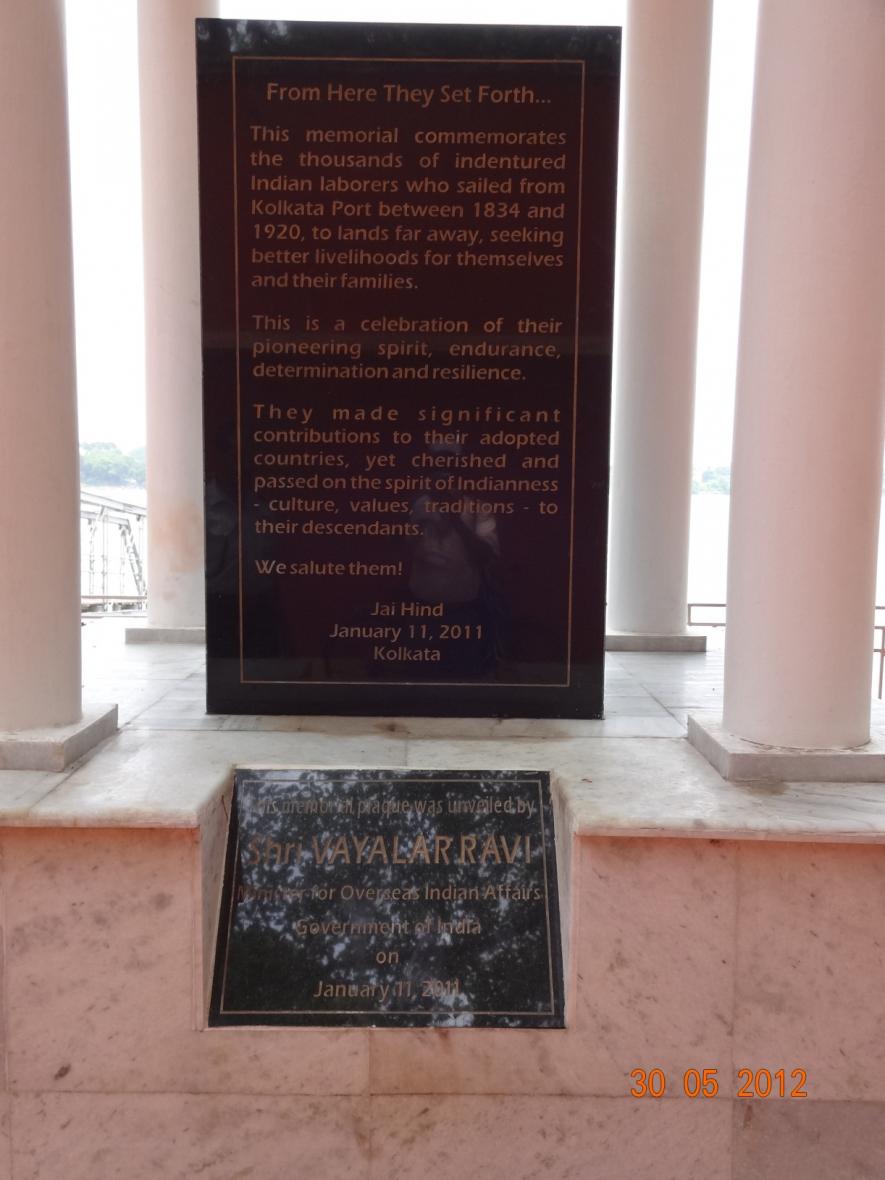
The Indian government built this monument in memory of 19th Century Indian indentured labour as late as in January 2011.
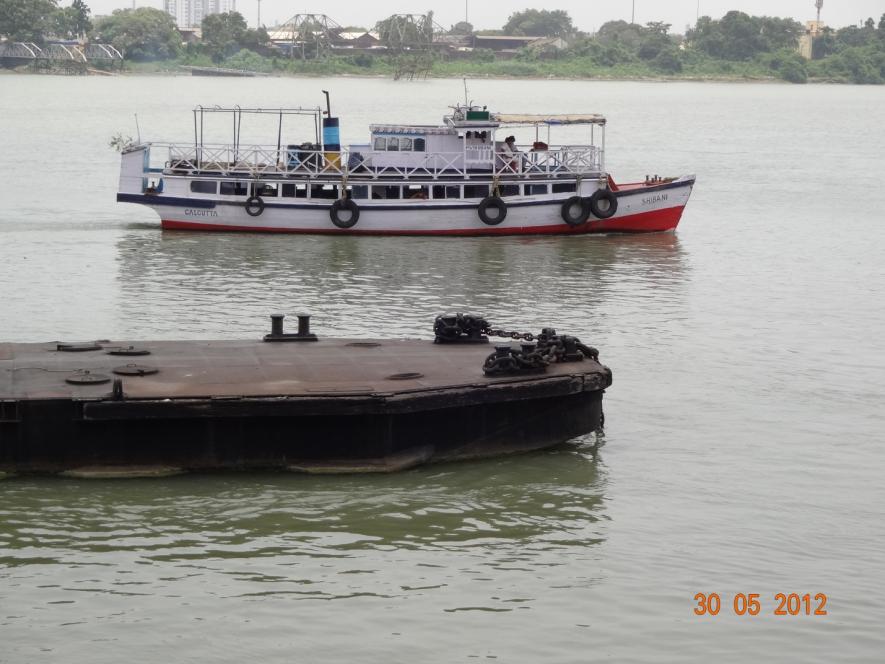
The indentured labour took off from these sea shores at Calcutta (Madras and Bombay too)
The British colonial government in India made certain rules called Colonial Emigration Acts V and XXXII of 1837 regarding ‘indentured’ conditions. Five years was the minimum term of indentured labour, after which a labourer could return to India at his or her own expense. To earn a return ticket, he/she was to perform 10 years indentured labour.
The regulations differed somewhat in various countries. Though on paper some safeguards were created, in practice these were never followed. The real condition of indentured labourers was close to the conditions of former slaves. The masters and their agents used to treat them in most cruel manner, beating-thrashing, raping their women, making women work in advanced pregnancy, sometime giving birth on work sites etc.
‘Suicide Hill’
Because of such cruelties, indentured labourers in Mauritius use to die by suicide, jumping from a particular hillock that got the name of ‘suicide hill’. It has now been turned into a monument.
The condition of indentured labour was no better in Fiji, though it may have been slightly less cruel in the Caribbean countries. The first emigration from British India started to Mauritius as early as 1834, immediately after the abolition of the Slavery Act was promulgated on August 1, 1834.
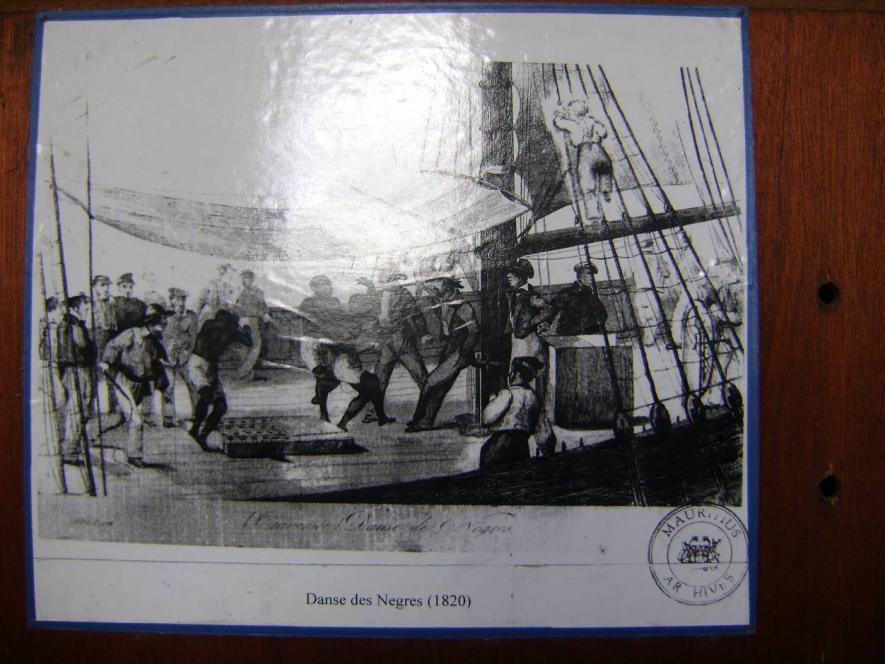
A photo of Negro slaves from Mauritius Archives Mauritius: Hub of Indian Labour
The first ship, Atlas from Calcutta, brought Indian labour to the shores of Mauritius on November 2, 1834. And till 1923, even after the indentured labour system was abolished 1920 onward, Mauritius received the maximum number of Indian indentured labour from the ports of Calcutta, Madras and Bombay. A total of 453,063 Indians landed in Mauritius during 1834-1923, the highest in any part of the world.
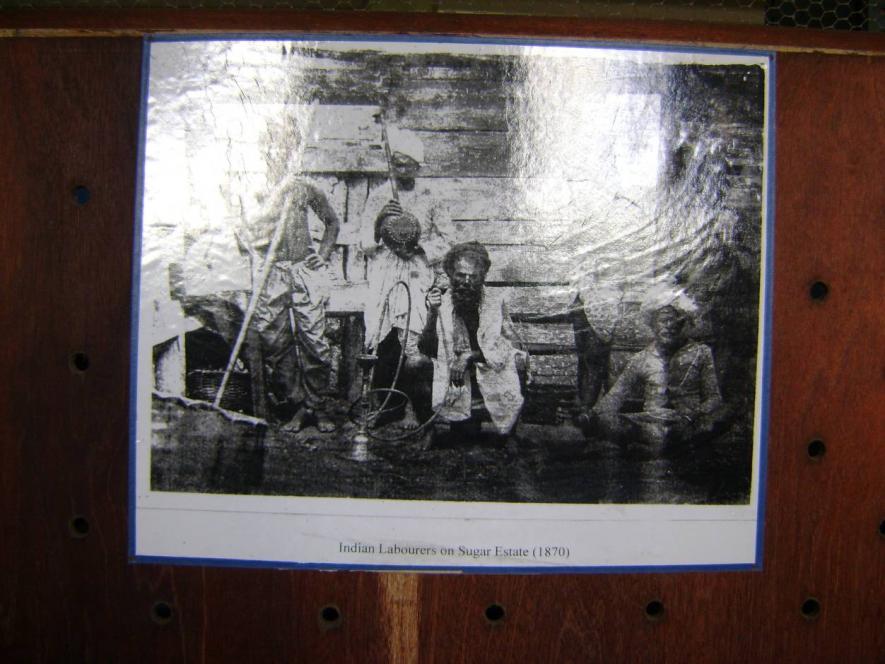
Indian Indentured labour in Mauritus-1870
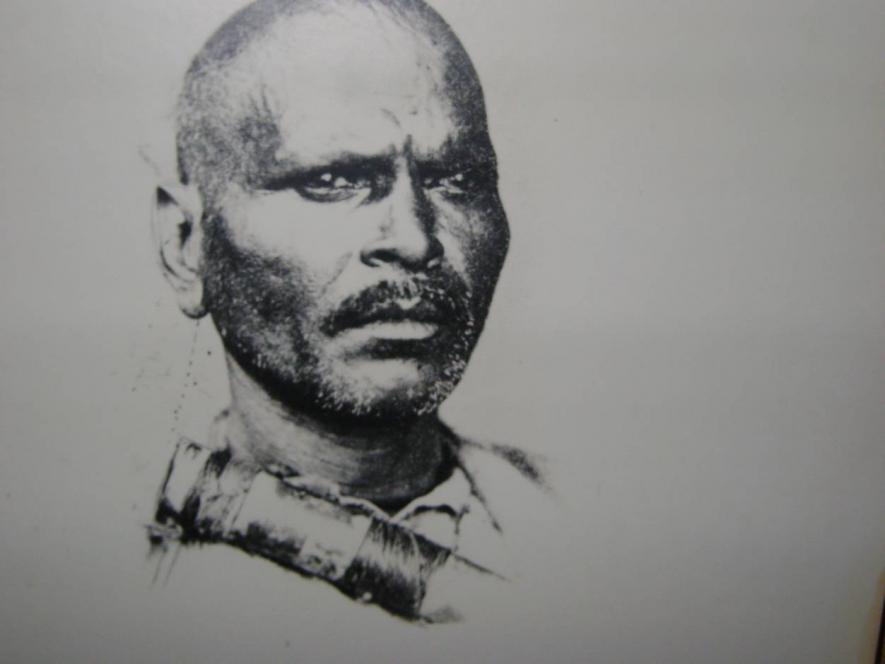
Compulsory neck wear of Indian indentured labour-Mauritius Folk Museum, Mahatma Gandhi Institute
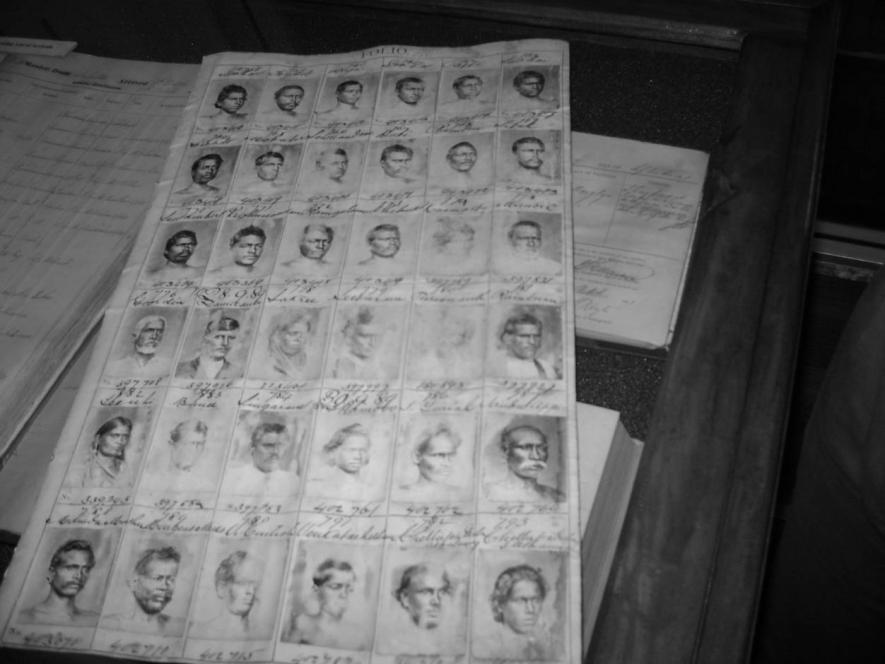
Photographs of indentured labour on arrival in Mauritius.
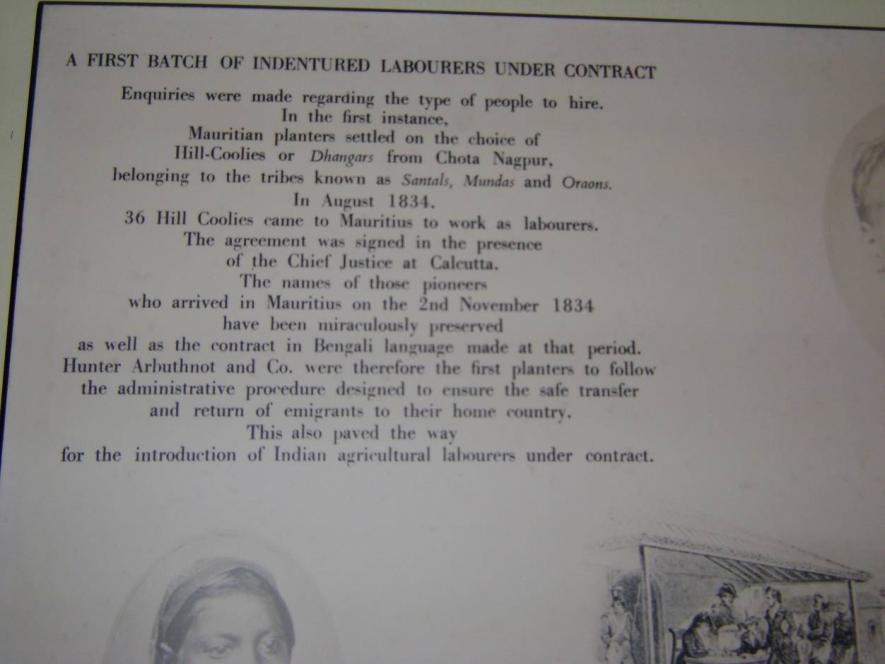
Details of the first batch of indentured labour in Mauritius Folk Museum
Guyana & Trinidad: Top Destinations
The second largest contingent of Indian indentured labour went to now called Guyana from 1838 to 1916. The first ship Hesperus with Indian labour arrived in Demerara on May 5, 1838, and was followed by more ships with 238,909 Indians on board.
Trinidad & Tobago was the third country to receive a large numbers of Indian labour from May 30, 1845 and here 147,596 Indians came as per Sat Balkaran Singh. The first ship to arrive in Trinidad was Fatel Razack from Calcutta, a total of 154 ships undertook 320 voyages from Calcutta, Madras and Bombay, to bring Indian indentured labour up to 1917. Out of these only 20% or so went back to India after the indentured system was abolished.
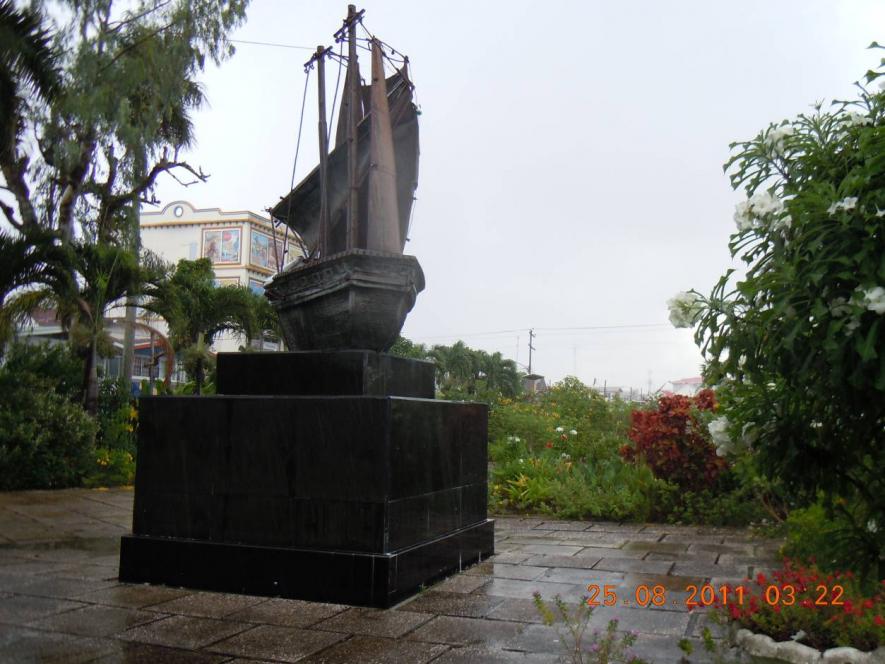
Replica of the first Indian ship Hesperus reaching Guyana on May 5, 1838.
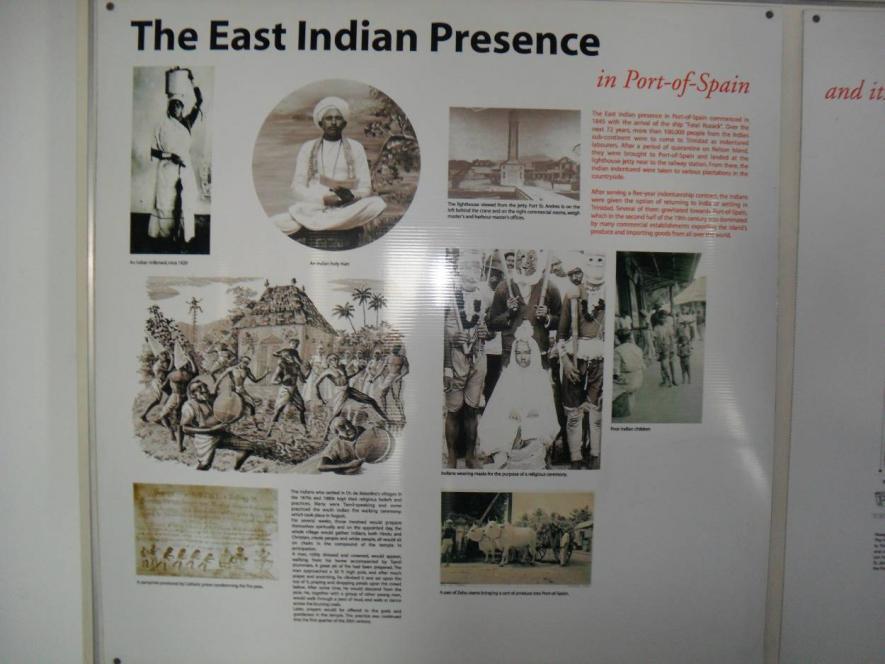
Indian indentured labour in Trinidad &Tobago-Port of Spain City Museum Collection

1903 ship Circe bringing Indians to Trinidad & Tobago
South Africa and Other Countries
South Africa also started receiving Indian laboor, mostly Muslims from Gujarat 1860 onward. Here the first ship Truro with Indian labour arrived from Madras on November 16, 1860. South Africa received 152,184 Indian labourers in that period.
The French and Dutch colonisers also struck deals with British Indian government to recruit Indian indentured labour with similar agreements. Thus, French colonialists recruited Indian indentured labour for French Guyana, Martinique, Guadalupe etc. Dutch colonisers got Indian indentured labour for Dutch Guyana, now named Suriname from 1873. The first ship Lala Rookh from India arrived there on June 5, 1873 with a total of 34,304 Indians reaching there till 1916.
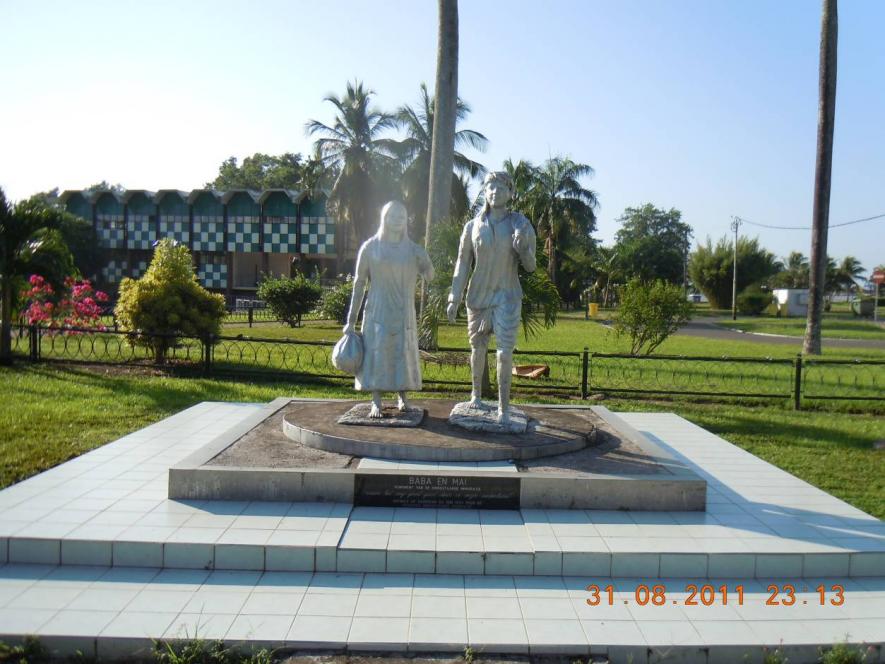
Baba-Mai, a symbolic statue in memory of Indian indentured labour in Paramaribo-Suriname.
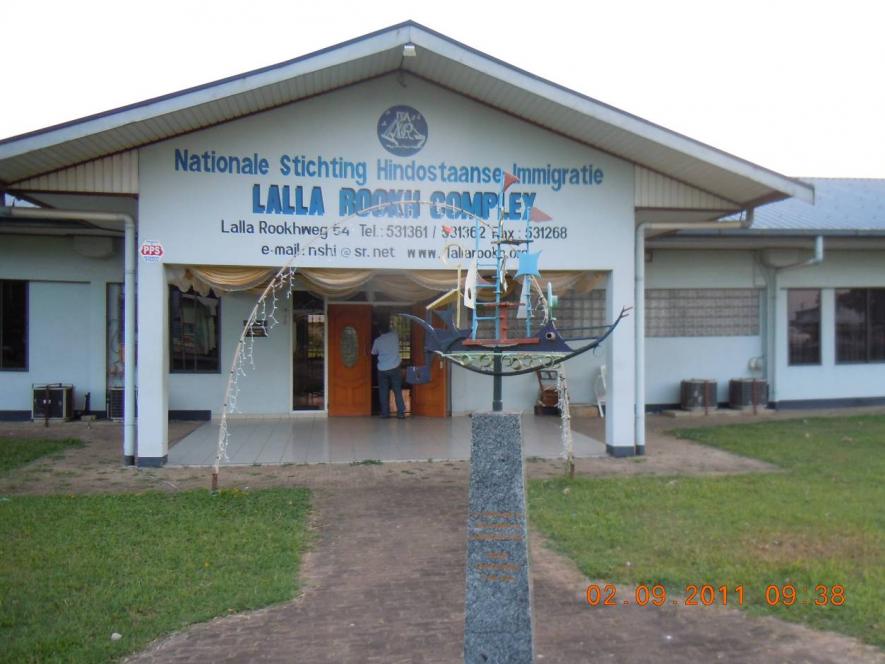
The first Indian ship Lalla Rookh memorial complex Paramaribo-Suriname
Fiji and Other Countries
Fiji under British regime was the last to recruit Indian indentured labour, where the first ship Leonidas arrived on May 14, 1879 . It got 60, 995 Indians till 1917.
The other countries to receive Indian indentured labour in this period were, Jamaica-36, 412, East Africa, including Kenya and Uganda-32,000, mostly Sikhs from Punjab, for building the Uganda-Kenya rail link; Reunion-26, 507, Seychlles-6,315, St Vincent-2,472, St Kitts-337, St Lucia-4,350, Grenada 3,200 etc.
A total of nearly 1.2 million or 12 lakh Indians travelled to different parts of the world during this period. In all these countries, Indian indentured labour went through hell, facing immense sufferings.
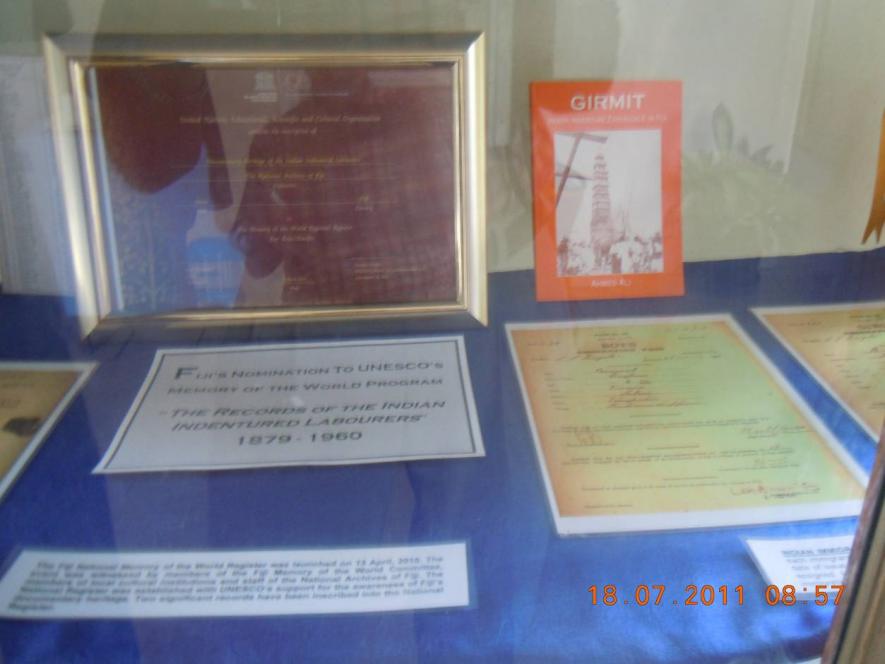
Indian indentured labour records in National Archives-Suva-Fiji
Mahatma Gandhi’s Role
Since Mahatma Gandhi was invited in South Africa as a lawyer to defend the rights of Indian businessmen there, the other countries also came into focus. In 1909, Gandhi spent a few days in Mauritius on his way back to India via sea journey. Mani Lal, a young advocate, who later married the daughter of a close friend of Gandhi, was sent to Mauritius in 1907. Mani Lal started a paper, Hindustani, from Mauritius in Gujarati and English, Hindi replaced Gujarati later. He spent a few years till 1910 in Mauritius and defended the rights of Indians. Later, he played a similar role in Fiji, where he went in 1912. Mani Lal was treated very harshly by British colonial authorities in Fiji and was made to leave the country in 1920.
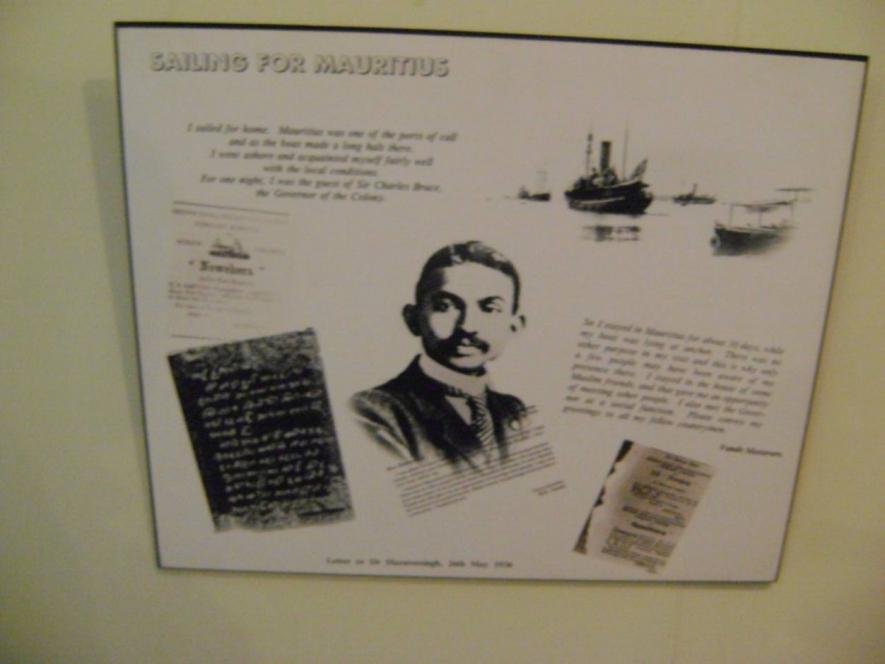
Mahatma Gandhi’s visit to Mauritius in 1909-Folk Museum Collection.
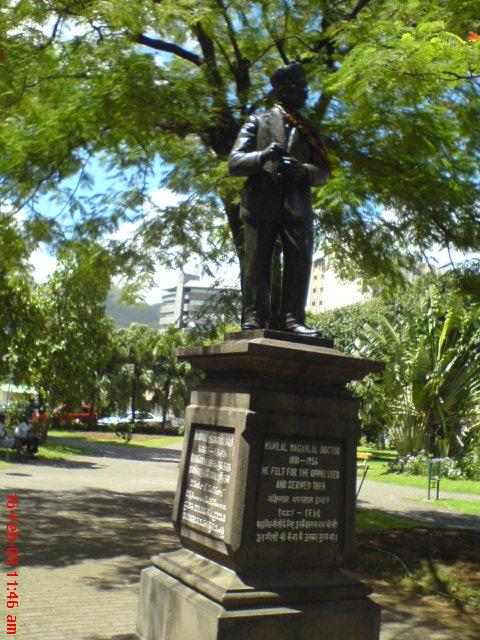
Dr Mani Lal’s statue in Port Louise-Mauritius
Documentation of Indentureship
The sufferings of Indian indentured labour are well documented in the creative Hindi literature of Mauritius and Fiji. Abhimanyu Anat is a celebrated Hindi writer in Mauritius and through his many novels like Lal Pasina (Red Sweat), the introduction of its French translation was written by French Noble Laureate Jean-Marie Gustave Le Clezio, he depicted the horrific sufferings faced by Indian indentured labour at the hands of sugar planters, mostly Europeans and their Indian agents, colonial police and other officials.
Joginder Singh Kanwal, in his novels like Savera and Karvat , also depicted the hardships and struggles of Fiji Indian labour. Munshi Rehman Khan, writing in Hindi and Urdu, did it for Indian labour in Suriname.
Unfortunately, in Trinidad and Guyana, people of Indian descent lost their languages as well and their sufferings were depicted in English much later, when their second or third generation became well versed in the language.
Peter Jailall from Guyana wrote about Indian indentured labour’s sufferings in his English poetry collection of recent times titled, Sacrifice - Poems on the Indian Arrival in Guyana.
V S Naipaul did not focus much on Indian indentured labour’s sufferings in Trinidad & Tobago, though he was born and brought up there, but made references to their sufferings in his classic autobiographical novel A House for Mr Biswas.
In India, too, writers like C F Andrews, who visited almost all countries where Indian labour migrated, at the behest of Mahatma Gandhi, Benarsidas Chaturvedi, a Hindi writer and journalist Lakshman Singh, husband of celebrated Hindi writer Subhadra Kumari Chauhan and member of All India Congress Committee (AICC), wrote plays like Coolie in Hindi, based on Indian labourers’ sufferings in Fiji. The play was immediately proscribed by the British authorities.
Tota Ram Shandilya , who returned from Fiji, wrote My Twenty One Years in Fiji, in Hindi, which is translated in English and now an important book in Fiji. In these countries, the freedom struggles against British colonialism began and were close to the struggles by Indian National Congress in India, like the movement by Shiv Sagar Ramgoolam in Mauritius, who became the first Prime Minister of independent Mauritius.
Cheddi Jagan and Left Leaders
Cheddi Jagan was one of the most important organisers and leaders of freedom struggle in British Guiana as leader of People’s Progressive Party, a party with Marxist ideas. His classic book-The West on Trial -- is a study of British colonialism.
In Kenya, Makhan Singh, a communist, fought alongside Jomo Kenyatta and his other colleagues for the freedom of Kenya. Monuments of struggles by Indian indentured labourers, along with other communities, are found in many countries.
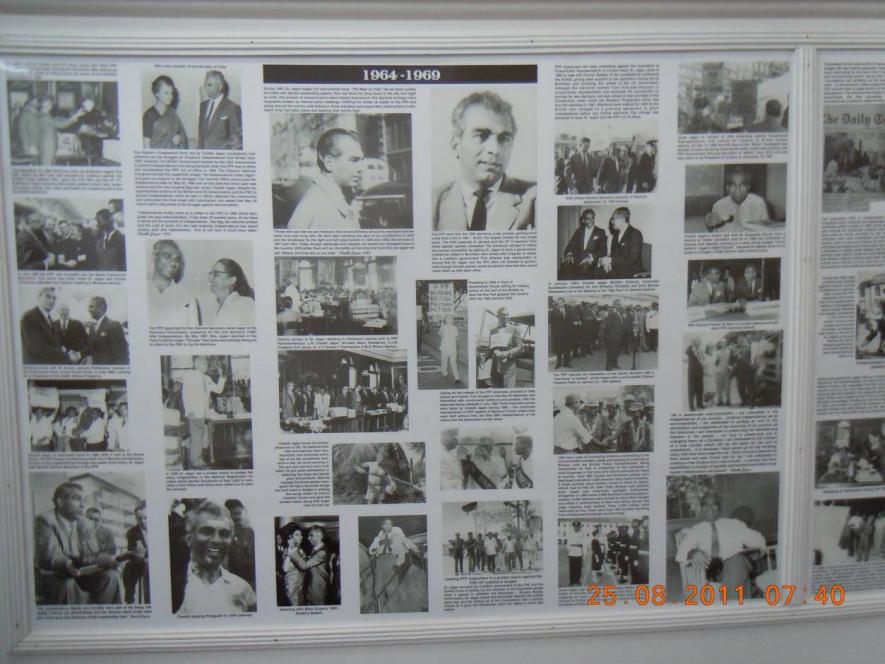
Dr Cheddi Jagan’s life in pictures in Guyana-Dr. Cheddi Jagan Research Centre Georgetown
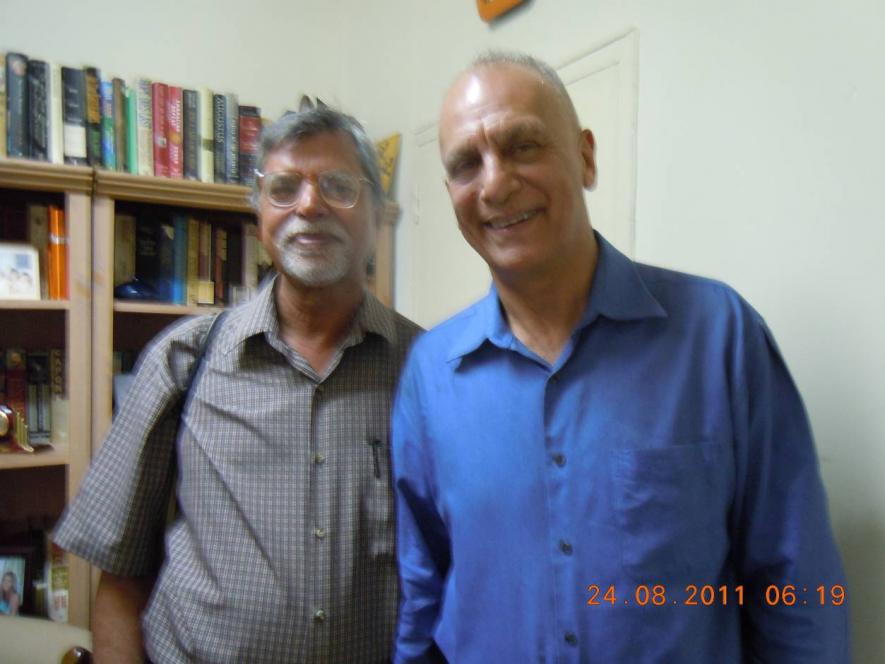
The author with Jr. Cheddi Jagan, a dentist. Senior Cheddi Jagan was also a dentist.
Walter Rodney’s Writings
There have been conflicts, rebellions in 1872, 1903 and 1912, 1913, 1924. Walter Rodney, one of the brilliant radical scholars of Guyana, depicted the conditions of Indians and other countries’ indentured labour emigration to Guyana in books like Lakshmi Out of India, History of the Guyanese Working People.
Rodney was assassinated in a young age on June 13, 1980 and Guyana national archives are now named after him. In Trinidad & Tobago, the massacre of Jahazis, as the East Indian indentured labour were called as they came on ships, took place in 1884 at the time of Eid.
CLR James: Black Power & India Labour
CLR James, the radical Marxist scholar-writer of Trinidad & Tobago, had focused upon Black and East Indian indentured labour conditions in his writings. During the March 1970 Black Power movement in Trinidad, there were banners and calls for Indo-African unity, though some people tried to scare Indians with rumours that Blacks would attack East Indians. To counter this, the Black Power movement took out a massive march in Caroni sugar plantation area, home to a large number of Indians, who did not join the march but showed hospitality to the marchers, thus frustrating the designs of those, who wanted to turn this most progressive movement as a Black-Indian conflict.
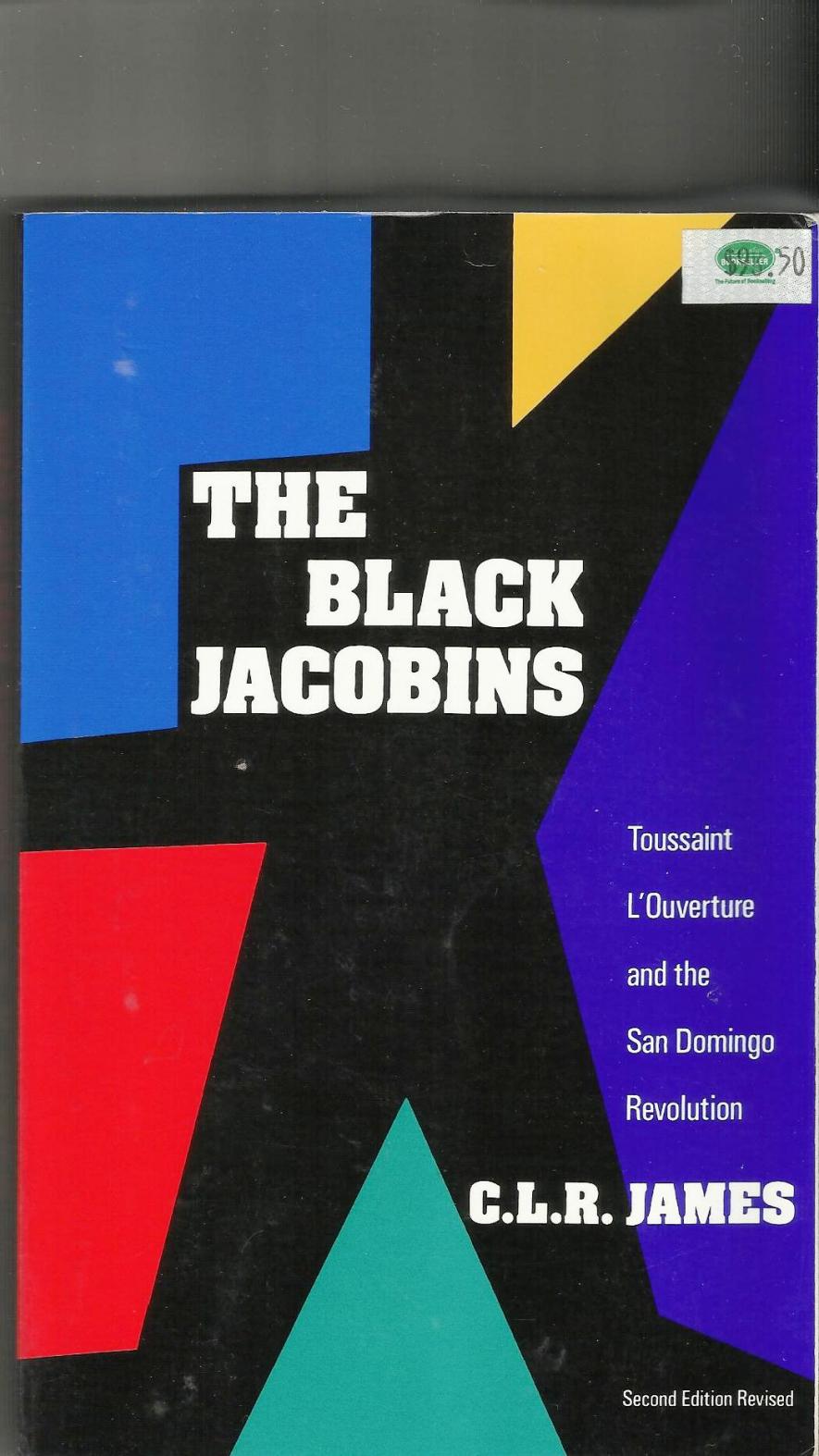
Need for Monuments
Strangely, Trinidad & Tobago has no monument in memory of Black and Indian sufferings in the country, whereas neighbouring Caribbean countries--Guyana and Suriname – have a number of monuments for both communities’ sufferings in their countries.
In Suriname, there is a monument in memory of 16 Indians and Indonesian indentured labour martyred at a sugar factory site while struggling for better wages and living conditions. At ‘suicide hill’ in Mauritius, stands a grand monument in memory of poor indentured labourers who died due to the cruelties inflicted upon them by the colonial authorities and sugar barons. In Fiji, workers struggled in February 1920, even after the abolition of the indentured labour system and the Fijian authorities crushed their trike and forced Mani Lal out of the country.
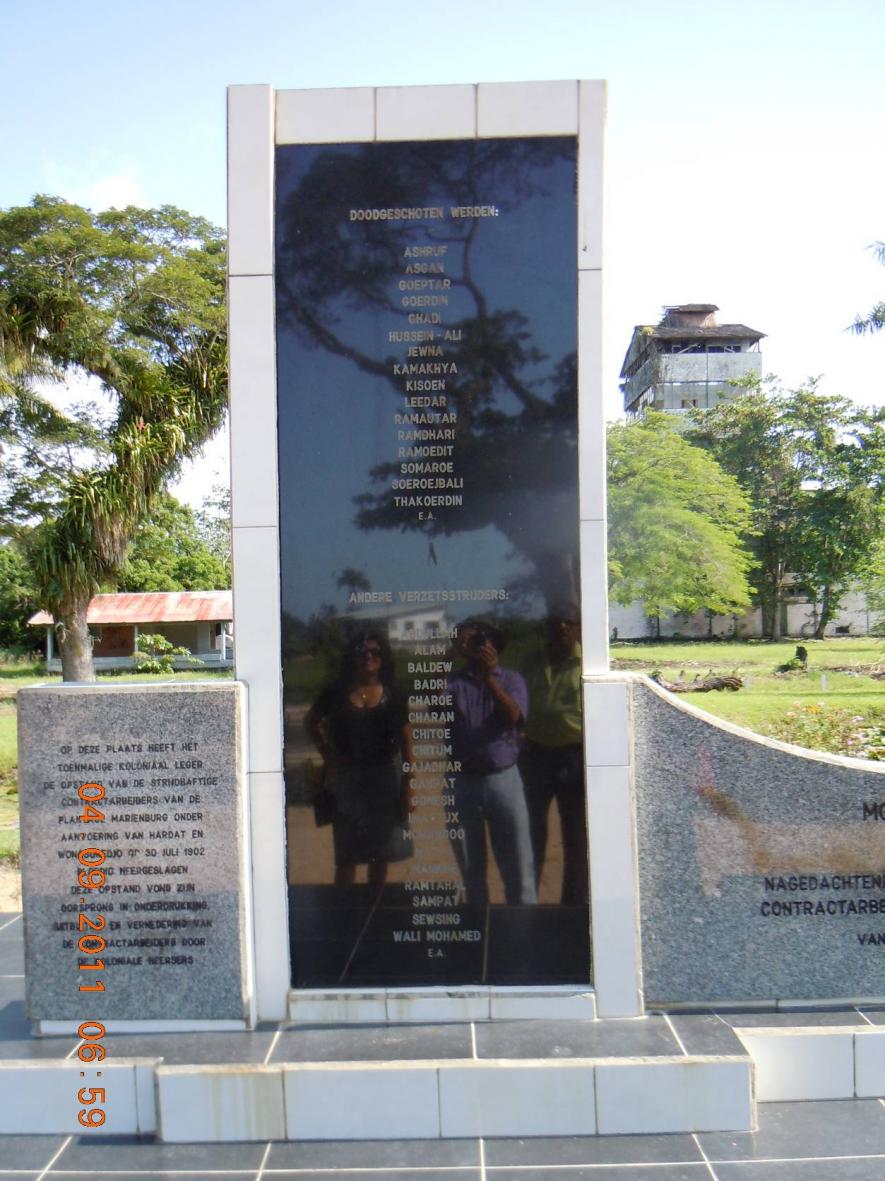
Monument in memory of 16 Indian and Indonesian indentured martyrs and other wounded labourers at sugar factory Marienburg struggle on July 30, 1902 in Suriname.

Slave Route Monument: The hillock from where Indian indentured labour died by suicide to escape torture.
Deliverance Day
Due to struggles in these countries and pressure by the national movement in India in favour of migrant Indian labour, the British Government had to finally abolish the ‘indentured labour’ system in 1917, through legislation to this effect, as they had to do in case of slavery in 1834/38.
The system was given lease/transition till the end of 1919 and from January 1, 1920, indentured Indian labour system came to a complete halt. So January 1, 1920 was hailed as Deliverance Day, as was the end of slavery hailed as Emancipation Day by Africans.
The irony is this that Indians in these countries never focused upon Deliverance Day, which is a more historic day, particularly for the present generation people of Indian descent in Mauritius, Guyana, Trinidad & Tobago, Suriname and Fiji, than so-called Indian Arrival Day, which is the day to mark the beginning of untold sufferings, deceit. Most of Indians recruited for this scheme of indentured labour were recruited by agents by telling all kinds of lies, like they are being taken to the countries of goldmines and would become rich, or lies like Mauritius is a country of Ramayana ‘s character Marich, trapping innocent, poor, needy Indian people.
In fact, the day to celebrate in these countries, uniformly, is January 1, as ‘Deliverance Day’, instead what is celebrated is semi slavery status. And use of the word ‘Arrival’, unwittingly, shows a colonial mindset, as only colonialists had the pleasure of celebrating arrival in colonies, like that of Columbus, Vasco de Gama kind of Spanish colonialists, who became instruments of future colonial conquers in the world of Africa, Asia and smaller countries of Latin/South America, Caribbean!
African-Indian relations
Another sad part of this whole anti-slavery and anti-indentured system movements and freedom from these, is that integration between East (wrong term, given by colonialists) Indians and Blacks have not taken place at a desirable level. Blacks and Indians were brought to these far off countries by colonial masters. Technically, they were free to go back to their root countries after their emancipation/deliverance. After bitter experience, some Indians returned home, but rather than being welcomed, they were treated with much contempt and misbehaviour due to the caste system and orthodox beliefs of crossing impure ‘kala pani’(black waters of the sea). So, many of them had to go back to their indentured countries.
Blacks had a more tragic past; their connection to their roots was completely lost due to the gap of centuries in between. They even lost the memory of the place from where they came. Under these circumstances, both these communities became naturalised citizens of these countries along with small communities of natives like Amerindians. In the process, they all became nationals of
It would have been natural for these nationals to merge and mingle with each other through inter-racial marriages, bringing into existence the new community of mixed race communities, which did not happen. Such was the cultural resistance to such efforts that the first feature film ‘Wan Pipel’ (One People) by Pim de la Parra, made in Suriname in 1976, brings this reality into focus.
In the film, Hindi-speaking Indian descent girl Rubia dares to fall in love with a black Suriname Roy. She is outcast harassed by her family, while Roy, who was in love with Dutch white girl in Holland while studying and was supposed to go back to Holland to complete his studies (he came to visit his dying mother) decides to stay back with Rubia. Roy’s father is as opposed to this relation as is Rubia’s family. After more than three decades of this film, conditions have not changed much. Even the East Indian descent actress, who played this role, was harassed in Suriname and had to shift to Holland.
La Divina Pastora
In Trinidad & Tobago, there is a black statue in Siparia town Catholic church, which is claimed as ‘Divina Pastora’ by Catholics who believe the statue comes from neighbouring Venezuela. But, Hindus claim it to be ‘Siparee ki Mai’, a folk image, which latter day Hindu religious fundamentalists distorted as ‘Durga’ or ‘Kali’.
Chinese Buddhists claim it to be a Chinese girl’s statue, while some believe in the myth of Kampuchean priests bringing it from Kampuchea.
The good part is that though the statue is part of a Church, Hindus visit the statue for worship or offerings every Friday, with happy arrangements with the Church, though some sectarian elements among Hindus in Trinidad do try to whip up a ‘temple’ narrative, like that in ‘Ayodhya-Babri Masjid’ dispute in India. But they cannot whip up hysteria like in India, as, in Trinidad & Tobago, with as many Christian and Muslims priests and commoners of Indian descent, people generally live in harmony.
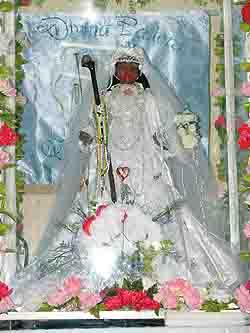
La Divina Pastora or Siparee ki Mai in Catholic Church in Siparia-T&T, some relate it to 17th Century Madras temple tradition-Guardian archives
Hindus and Christians of East Indian descent claim the Jahazy Revolt of 1884 in Trinidad as part of Indian tradition and not just a Muslim revolt. It is called the ‘Jallianwala Bagh’ of Trinidad, though the number of killings the state attack was nowhere near Jallianwala Bagh in Amritsar, where on April 13, 1919, hundreds of people were shot dead by the notorious General Dyer’s forces, while attending a peaceful protest meeting.
The interesting part of indentured labour immigration to different countries is that in Mauritius, Guyana, Trinidad & Tobago, Suriname and Fiji, a large number of people went from east Uttar Pradesh (UP) and Bihar, though there were some from Bengal and South India as well.
In South Africa and East Africa, the majority of labour was from Gujarat, Punjab and South India. Later, in the early 20th century, Punjabis went as free labour to the US, Canada and the UK. While only Mauritius has been able to preserve its Indian demographic and cultural structure, most other countries of the Indian diaspora are now getting mixed and mingling with other diaspora in terms of language use.
Mauritius has still been able to preserve Indian languages—Bhojpuri, Hindi, Tamil, Telugu, Marathi and Urdu, where a full-fledged department of Indian languages functions in the Mahatma Gandhi Institute, as part of University of Mauritius to teach these languages, apart from Sanskrit. South Indian temples exist as much as other temples in Mauritius and Fiji.
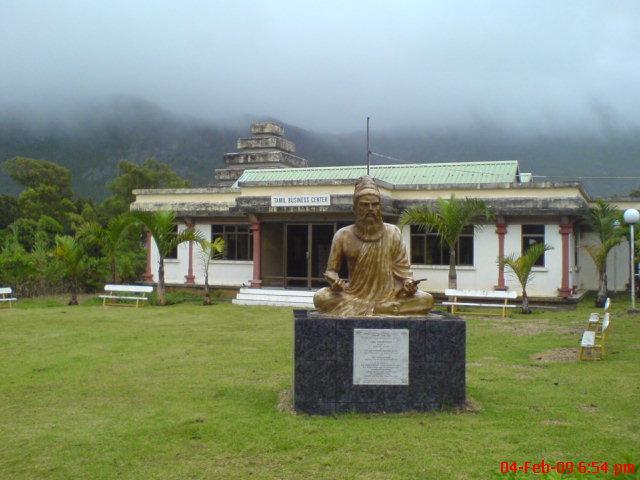
Thiruvallavar bust in Moka-Mauritius.
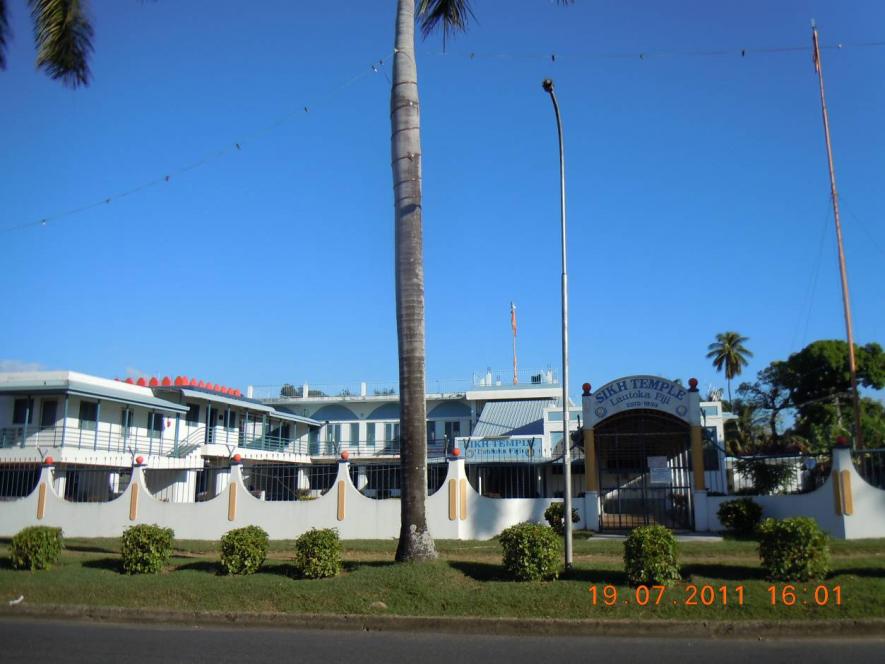
Sikh Gurdwara in Fiji-Lautoka.
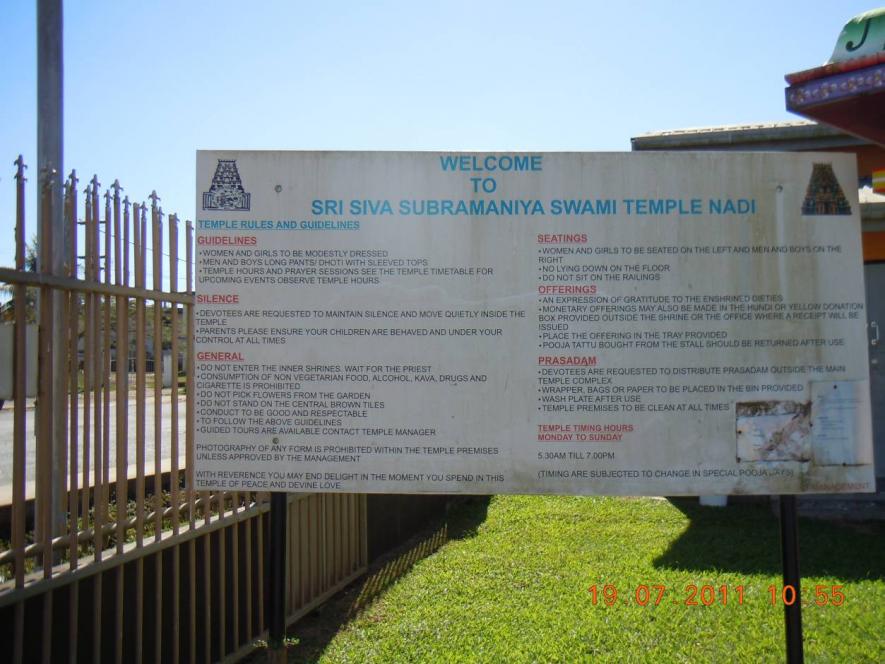
Biggest Tamil Temple in Nadi-Fiji.
Fiji and Suriname have been able to preserve Hindi as a common language of all people of Indian descent, but other countries have mostly lost the existence of Indian languages in public life and these may be just surviving in some homes and some religious gatherings. Though a large number of Indian indentured labourers returned to India after completion of their term, but a larger number stayed back and now, after three generations, have become prosperous in these countries.
Indian ‘Arrival Day’
The celebration of ‘Indian Arrival Day;’ started in these countries, after Indian descent people became prosperous and started sharing political power as part of ruling classes. Mauritius, from the very beginning, had Indian descent people in political power. After Shiv Sagar Ramgoolam, Anerood Jugannath and Naveen Chander Ramgoolam (son of Shiv Sagar Ramgoolam) are sharing power, though in different parties. Pravind Jugannath, son of Aniruddh Jugananth, is Prime Minister since 2017.
In Trinidad & Tobago, after Basdeo Pandey remained Prime Minister in 1997, Kamla Prasad Bissesar of Indian descent remained Prime Minister during 2010-15. These days Keith Rowley is Prime Minister.
In Guyana, Cheddi Jagan , a Marxist of Indian descent, had been most popular leader of the country, remaining Prime Minister and President for many years. Bharat Jagdeo of Indian descent, from Cheddi Jagan’s People’s Progressive Party has remained President of the country since the last almost a dozen years and his successor is again of Indian descent, Donald Ramoutar, of the same party, who won the elections held in November, 2011. Irfan Ali is the Guyana President now.
In Fiji, Mahendra Chaudhary from Rohtak in Haryana was the fourth Prime Minister of the country for a short period. Suriname also had Indian descent Presidents of the country like Fred Ramdutt Misier during 1982-88 and Ramsewak Shankar during 1988-90. Jules Ajodhia had been Vice President during 1991 and 2000-2005, while Pretaap Radhakishun remained Vice President during 1996-2000, Ramdin Sarjue remained Vice President during 2005-2010. Surinamese Vice President is equal to Prime Minister’s position and chairs cabinet meetings. Pretaap Radhakaishun remained Prime Minister of Suriname, the only Indian descent person to hold the post, for a brief period during 1986-87. However it was in Jaggernath Lachmon, a former speaker of National Assembly or Parliament with 50 members, Suriname had a strong leader of Indian descent people, whose statue finds place of pride in Independent Square of Paramaribo, capital of Suriname.
The Surinamese President, the first ever from Indian background, is Chandrika Prasad Santokhi, a Hindu religious, who was seen doing pooja in Varanasi on Thursday, January 5. 2023.
New Zealand had its Governor General Anand Satyanand from Indo-Fijian background. There have been ministers in many countries from Indian descent people in South Africa, Malaysia, Singapore, Tanzania, Zambia etc.
The rise of Indian descent people, after becoming prosperous and part of ruling classes and holding political power, has created a sense of suspicion in other communities in these countries, particularly as the event of ‘Indian Arrival’ is not marked as a sombre event, with remembrance of past sufferings of Indian indentured labour.
At most of these places, this event is celebrated with pomp and show, like a happy festival, which is supported by the Indian government as part of diplomatic duties.
When Africans celebrate Emancipation Day, they bring into focus the horrible days of slavery through films, exhibitions, lectures, songs and make it an event to remember their ancestors for their sacrifices for the prosperity of present generation; but Indian Arrival Day rarely focuses upon the sufferings gone through by their ancestors, except in some seminar papers.
Sadly, the present generation does not have much knowledge about the suffering of their ancestors and are too engrossed in the pleasures of consumerism ushered in by prosperity.
Indian descent people in these countries need to learn from history and review their days of celebrations. It is January 1, as ‘Deliverance day, which should be celebrated in all these countries. Arrival Day may be marked, like a day of penitence, by way of fasting, in memory of those ancestors, who suffered during their indentured labour bondage.
The writer is retired professor & former chairperson at the Centre of Indian Languages, Jawaharlal Nehru University, New Delhi. In 2011, he was visiting professor at Hindi Chair in The University of the West Indies, St Augustine. At present, he is honorary advisor to Bhagat Singh Archives and Resource Centre New Delhi.
A part of this article was published in Daily Trinidad Guardian of Port of Spain. Photographs with date marks from author’s camera.
Get the latest reports & analysis with people's perspective on Protests, movements & deep analytical videos, discussions of the current affairs in your Telegram app. Subscribe to NewsClick's Telegram channel & get Real-Time updates on stories, as they get published on our website.









